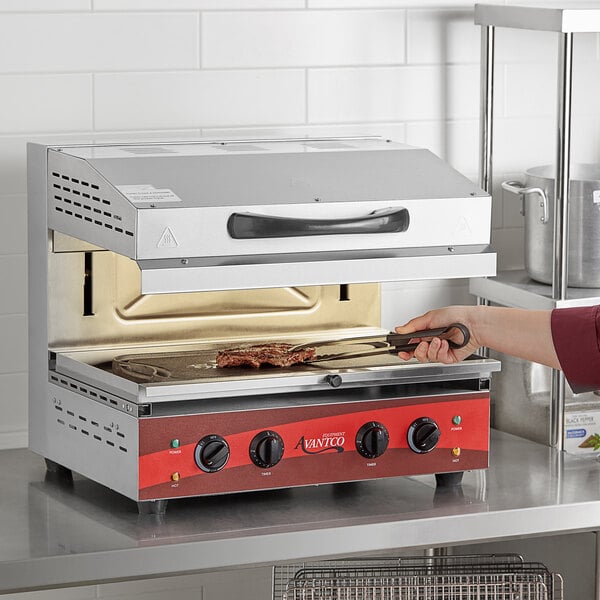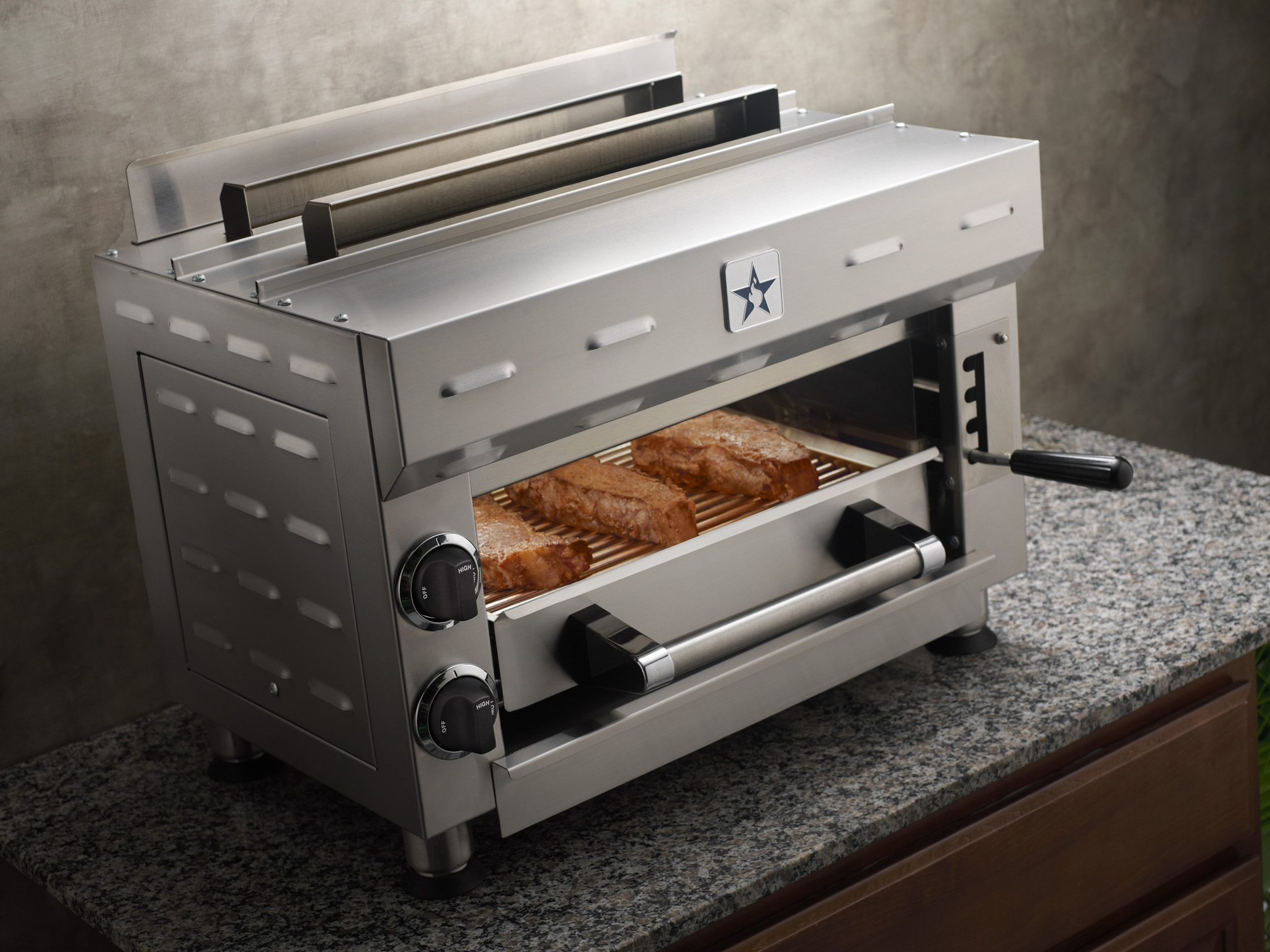As an Amazon Associate KitchenwareSets.com earns from qualifying purchases.
What Is a Salamander? The Kitchen Broiler Explained
Have you ever wondered how restaurants achieve that perfect, crispy finish on dishes like crème brûlée or a beautifully browned crust on a casserole? Or how they quickly melt cheese to golden perfection on French onion soup? The secret weapon behind these culinary feats often isn’t a standard oven or broiler, but a specialized piece of equipment known as a salamander. Many professional kitchens rely on salamanders, yet home cooks and even some culinary novices may not be familiar with this powerful tool. It can be confusing to differentiate a salamander from other kitchen appliances, and understanding its specific uses and benefits can be a challenge.
In a kitchen, a salamander is a high-powered, overhead broiler used primarily in professional settings to rapidly brown, grill, melt, and caramelize food items. It’s distinct from conventional ovens due to its intense, direct heat that efficiently perfects dishes like gratins and steaks.
This guide demystifies the kitchen salamander, exploring its various types, functionalities, and advantages. We’ll delve into the nitty-gritty of how it compares to traditional ovens and broilers, and why it’s an indispensable tool for chefs aiming for culinary excellence. You will discover expert tips, insider insights on efficient usage, and up-to-date maintenance practices, providing everything you need to know about this key appliance in the world of commercial cooking.
Key Facts:
* Rapid Heating: Salamanders can reach temperatures exceeding 1000°F, significantly reducing cooking times compared to conventional ovens.
* Energy Efficiency: Because of their focused heat and quick operation, salamanders can be more energy-efficient than leaving a standard oven broiler on for extended periods.
* Versatility: Salamanders are not just for finishing; they can also be used for cooking items like thin cuts of meat and fish.
* Space Saving: Many salamander models are designed to be mounted above a range, saving valuable counter space in busy kitchens.
* Precision Cooking: The adjustable racks in most salamanders allow for precise control over the cooking intensity.
What are the Primary Uses of a Salamander in a Kitchen?
A salamander in a kitchen is primarily used for broiling, browning, melting cheese, caramelizing sugar, toasting, and reheating dishes. Its high-intensity heat allows for quick and efficient cooking, achieving desired textures and finishes on a variety of foods.
A salamander’s versatility extends beyond just these core functions. It’s a secret weapon in the chef’s arsenal, capable of perfecting a wide range of dishes with speed and precision. Let’s take a closer look:
Broiling and Grilling with a Salamander
Broiling and grilling in a salamander involves positioning food on the adjustable rack close to the overhead heating element to expose it to intense, direct heat. This is ideal for creating a crispy, charred surface on meats, fish, and vegetables.
- Prepare the Food: Season your steaks, fish fillets, or vegetables as desired.
- Preheat the Salamander: Allow the salamander to preheat fully to its maximum temperature. This ensures a quick sear and prevents sticking.
- Position the Rack: Adjust the rack to the appropriate height. For a strong sear, place the food closer to the heating element.
- Monitor Closely: Salamanders cook very quickly. Watch the food carefully to prevent burning.
- Rotate if Necessary: For even cooking, rotate the food halfway through the cooking process.
According to research from Harvard Medical School, grilling, when done correctly, can be a healthy cooking method, reducing fat content as it drips away.
Browning and Finishing Dishes
Browning dishes in a salamander utilizes the intense overhead heat to create a golden-brown, crispy top layer on casseroles, gratins, and other baked dishes. This not only enhances the visual appeal but also adds a delightful textural contrast.
Imagine a bubbling mac and cheese, fresh from the oven. While delicious, it might lack that inviting, golden-brown crust. A few minutes under the salamander’s intense heat transforms it, creating a crispy, flavorful top layer that elevates the dish to a new level. This technique works wonders on gratins, lasagnas, and even shepherd’s pie.
Melting and Caramelizing
Melting cheese and caramelizing sugar are core functions of a salamander, utilizing its rapid, high heat to achieve perfect consistency without overcooking the underlying food. This is essential for dishes like French onion soup and crème brûlée.
For French onion soup, the salamander quickly melts the Gruyère cheese, creating a gooey, bubbling topping that stretches enticingly with each spoonful. And for crème brûlée, the intense heat rapidly caramelizes the sugar, forming a brittle, glass-like crust that cracks delightfully under the spoon, contrasting beautifully with the creamy custard below.
What Exactly is a Salamander in a Kitchen?
A salamander in a kitchen is a specialized cooking appliance, often a type of broiler, that provides intense, overhead heat. It’s designed for quickly grilling, browning, toasting, and finishing dishes, and is commonly used in professional kitchens.
Unlike a standard oven or broiler, which heats food from all directions, a salamander focuses its energy from above. This allows for rapid cooking and precise control over the browning and finishing process. Think of it as a supercharged broiler, capable of reaching much higher temperatures and delivering results in a fraction of the time.
Key Components of a Salamander Broiler
Salamander broilers, while varying in design, share several key components:
- Heating Elements: These can be infrared, radiant, or gas-powered burners, generating intense heat.
- Adjustable Racks: This allows chefs to control the distance between the food and the heating element, fine-tuning the cooking intensity.
- Temperature Controls: These provide precise control over the heat output, allowing for a range of cooking applications.
- Drip Trays: These collect any fat or juices that drip from the food, making cleanup easier.
- Grease Pan: All Salamander have a grease pan and a height-adjustable cooking grate.
How Does a Salamander Differ from a Standard Oven or Broiler?
| Feature | Salamander | Standard Oven/Broiler |
|---|---|---|
| Heat Source | Overhead, high-intensity | All-around (oven), top-down (broiler) |
| Temperature | Significantly higher (often exceeding 1000°F) | Lower (typically up to 550°F) |
| Cooking Time | Much faster | Slower |
| Size | Generally compact | Larger (oven), varies (broiler) |
| Primary Use | Finishing, broiling, browning, melting | Baking, roasting, broiling (less intense) |
A salamander differs from a standard oven or broiler primarily in its heat source and intensity. Salamanders use overhead, high-intensity heat for quick cooking, while ovens and broilers often have less intense and more distributed heat. The concentrated heat of a salamander allows for rapid browning and melting, perfect for finishing dishes, while a standard oven or broiler is better suited for longer cooking processes like roasting or baking.
According to WebstaurantStore, salamander ovens are dedicated to broiling foods at higher temperatures than a traditional oven’s broil setting.
What are the Different Types of Salamanders?
Salamanders are categorized by power source (electric or gas), heating style (infrared or radiant), and installation type (countertop, wall-mounted, or range-mounted). Each type offers different benefits depending on kitchen needs and volume.
Choosing the right salamander depends on factors like kitchen size, cooking volume, and the types of dishes frequently prepared. Let’s examine the differences.
Electric vs. Gas Salamanders
Electric Salamanders:
- Generally lower output compared to gas.
- Suitable for smaller kitchens or lower-volume operations.
- Often have more precise temperature control.
- They have infinite controls for easy and quick control over the heating cycles.
Gas Salamanders:
- Higher output, ideal for high-volume kitchens.
- Can use natural gas or liquid propane.
- Often preferred for their quick heating and intense heat capabilities.
The following video demonstrates the complete process of testing a CPG gas Salamander:
This tutorial covers burner testing, connection verification, and common troubleshooting scenarios.
Infrared vs. Radiant Heating in Salamanders
Infrared Salamanders:
- Use infrared elements to generate intense, direct heat.
- Known for their rapid heating and searing capabilities.
- Ideal for quickly browning and finishing dishes.
Radiant Salamanders:
- Use radiant heat (typically from gas burners) to distribute heat more evenly.
- Suitable for a wider range of cooking applications, including broiling and grilling.
- Offer a good balance between speed and evenness of cooking.
According to research published by ScienceDirect, radiant heating systems offer efficient heat distribution, making them a popular choice in various applications.
Installation Types: Countertop, Wall-Mounted, and Range-Mounted
Countertop Salamanders:
- Compact and portable, ideal for small spaces or kitchens with limited counter space.
- Easy to install and move around.
- Typically electric-powered.
Wall-Mounted Salamanders:
- Save valuable counter space.
- Can be positioned at an optimal height for easy access.
- Available in both electric and gas models.

Range-Mounted Salamanders:
- Integrated with a range, creating a streamlined cooking station.
- Offer convenience and efficiency in high-volume kitchens.
- Typically gas-powered.

Tip: When choosing a salamander, consider your kitchen’s layout, available space, and power source.
FAQs About What is a Salamander in a Kitchen:
Why is it called a salamander in the kitchen?
The name “salamander” comes from the mythical creature, a lizard believed to be able to withstand fire. This aptly describes the kitchen appliance’s ability to generate and operate at extremely high temperatures.
What’s the difference between a grill and a salamander?
A grill typically heats food from below, while a salamander heats from above. Salamanders also reach much higher temperatures, making them ideal for broiling and finishing dishes. According to Capic, Salamanders achieve grilling temperatures higher than standard ovens.
What does a salamander do for cooking?
A salamander is used for broiling, browning, melting cheese, caramelizing sugar, toasting, and reheating food. Its intense overhead heat allows for quick and efficient cooking, achieving desired textures and finishes.
Can I use a salamander at home?
While salamanders are primarily designed for commercial kitchens, smaller, countertop models are available for home use. However, they require proper ventilation and safety precautions due to their high heat output.
What is the typical temperature range of a salamander?
Salamanders can reach temperatures well over 1000°F (538°C), although many models offer adjustable temperature controls for greater versatility.
How do I clean and maintain a salamander?
Regular cleaning is essential. Always allow the unit to cool completely before cleaning. Remove the drip tray and grates, and wash them with warm, soapy water. Wipe down the interior and exterior surfaces with a damp cloth.
Are salamanders energy-efficient?
Due to their fast cooking times and focused heat, salamanders can be more energy-efficient than using a standard oven broiler for extended periods.
What are the safety precautions when using a salamander?
Always use caution due to the high temperatures. Use oven mitts or tongs to handle food and adjust the rack. Ensure proper ventilation to prevent the buildup of smoke and fumes. Never leave a salamander unattended while in operation.
What size salamander do I need for my kitchen?
The size of the salamander depends on your kitchen’s volume and needs. Smaller, countertop models are suitable for low-volume operations, while larger, range-mounted units are ideal for busy commercial kitchens.
Where can I buy a salamander for my kitchen?
Salamanders are available from restaurant supply stores, both online and brick-and-mortar. Popular online retailers like WebstaurantStore and Amazon also offer a wide selection.
What is a salamander in a kitchen called?
Other common names include salamander broiler, cheese melter (although this is a slightly different appliance), and overhead broiler. Learn about Spice Kitchen.
Summary:
A salamander is a powerful kitchen tool that provides intense overhead heat for a range of culinary tasks. Its efficiency and versatility make it a valuable asset in professional kitchens, offering unique benefits compared to standard ovens and broilers. This specialized appliance allows chefs to achieve perfect browning, melting, and caramelizing, enhancing the flavor and presentation of a wide variety of dishes. From quickly melting cheese on French onion soup to creating a crispy crust on crème brûlée, the salamander delivers exceptional results with speed and precision. Understanding the different types of salamanders and their specific applications is crucial for selecting the right model for your kitchen’s needs. The detailed information presented equips you with the knowledge needed to leverage a salamander and optimize your cooking processes. Check also for What Kitchen Items Are Made of Calcium Carbonate?.
What culinary creations will you perfect with your new understanding of the kitchen salamander? Share your thoughts and questions in the comments below!
